In Allsvenskan 2020, the schedule is tight and already 18 rounds of league games have been played. As the newly promoted team, Mjällby AIF are safe from the relegation battle for now, having obtained 24 points and sitting comfortably as the 8th team in the league.
In Marcus Lantz’s squad, some players are performing quite well and one of them is Besard Sabović, while another player who contributed hugely to the team’s attack is Moses Ogbu, the striker wearing shirt #90 of the team.

The above table shows the top goalscorers in Allsvenskan so far, and three players stand out with nine goals in their bag – Christoffer Nyman, Stefano Holmquist Vecchia and Jesper Karlsson. There are another three players who scored eight goals, also as the potential contenders for the golden boot, and Ogbu is one of them, with the fewest minutes on the pitch (1007).
In this player scout report, I’ll dissect Ogbu’s performance through tactical analysis and data, suggesting how he could fit Lantz’s system and other potential tactics.
Player profile and stats
Born in Osogbo in 1991, Ogbu is 29-year-old already, right at the peak of his career. The Nigerian player is an experienced veteran, having more than 221 professional appearances in four different countries (the chart below excluded history at Al-Ain given the scarce stats on Transfermarkt).
Ogbu is the academy product of FC Dynamo, beginning his professional his career at IK Sirius at Ettan Norra, then joining Jönköpings Södra IF in 2016. After rejoining Sirius for a few years, Ogbu left Sweden to play for Al-Ain in Saudi Arabia and Grimsby Town in England, and has also played against Chelsea in the Carabao Cup. This March, Mjällby signed him on a free as one of the striker options for Lantz.
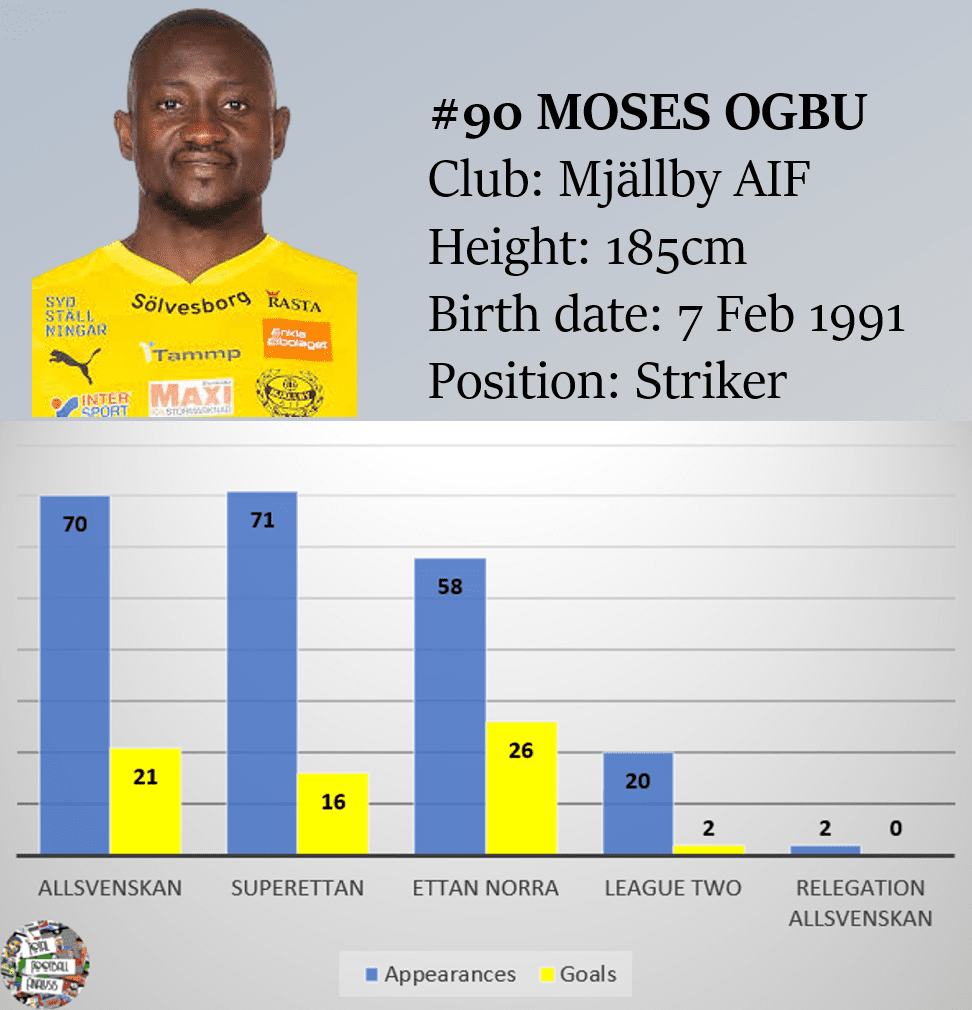
Ogbu played 57% of minutes this season, starting 50% of the games for Mjällby according to Transfermarkt. From his 15 appearances at Allsvenskan – the top-tier in Sweden – Ogbu registered eight goals and two assists.
The table below sums up the general statistics of Ogbu on a 90-minute basis. The striker has 0.71 goals on average and I will compare his offensive statistics with the rest of the league in the next paragraphs. The physical stats of Ogbu are not extremely impressive: the aerial duel % is 30.8% from 6.97 per game, while overall duels won stand at 40.4%.

Although being deployed as a striker, Ogbu does not merely stay at the centre and waits for the ball. Instead, the movements and positionings of the Nigerian striker cover most of the opposition’s half, reaching almost every vertical zone on the pitch.
The heat map below sums up the activities of Ogbu’s games in 2020. The 29-year-old player can operate at both half-spaces, even in zone 16 and zone 18. Maybe this is the result of Lantz’s tactics since Mjällby played with a 3-5-2 on most occasions and there were always two strikers on each vertical half who supported each other.
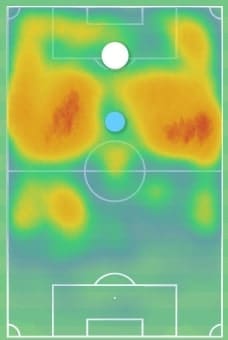
Comparing Ogbu with his counterparts at Allsvenskan, we extracted stats from a total of 28 strikers in the same league and filtered them to show players with seven or fewer starts. By using xG per 90 and Shots per 90, the quality of shots should be indicated.
The scatter chart is separated into four quadrants by the average of each metric. Ogbu is in the top-left quadrant; that means the number of shots (1.88 to mean: 2.22) is below average but with above-average xG (0.37 mean:0.34). This implies the quality of Ogbu’s every shot is high, maybe because of getting into good positions to pull the trigger.
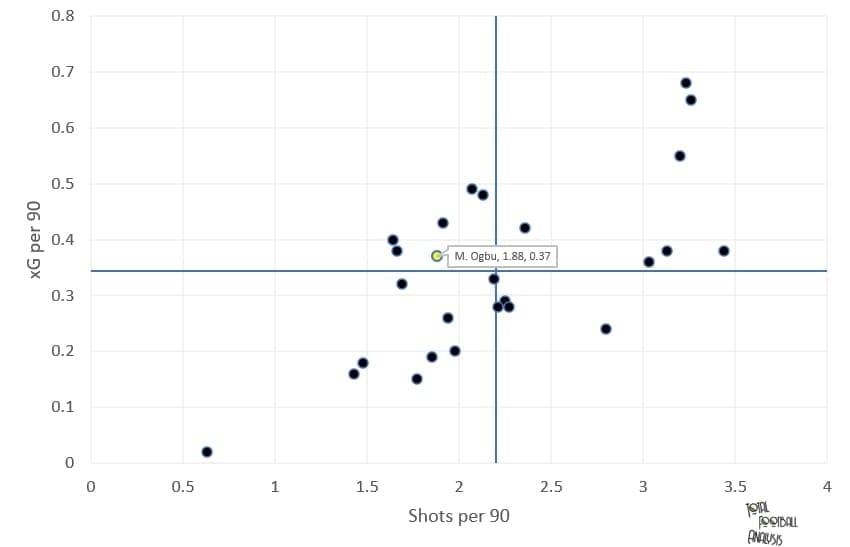
The second domain that I want to measure is the threat to goal, using xG per 90 and xA per 90 as the metrics. Comparing the data collected with other strikers at Allsvenskan, I found out that Ogbu is quite dangerous in the offensive third.
Again, the quadrants are divided by the average of each metric – Ogbu stayed in the top-right quadrant, suggesting the player is among the best performers on the list. His 0.37 xG is above average while 0.17 xA ranked third in the chart.
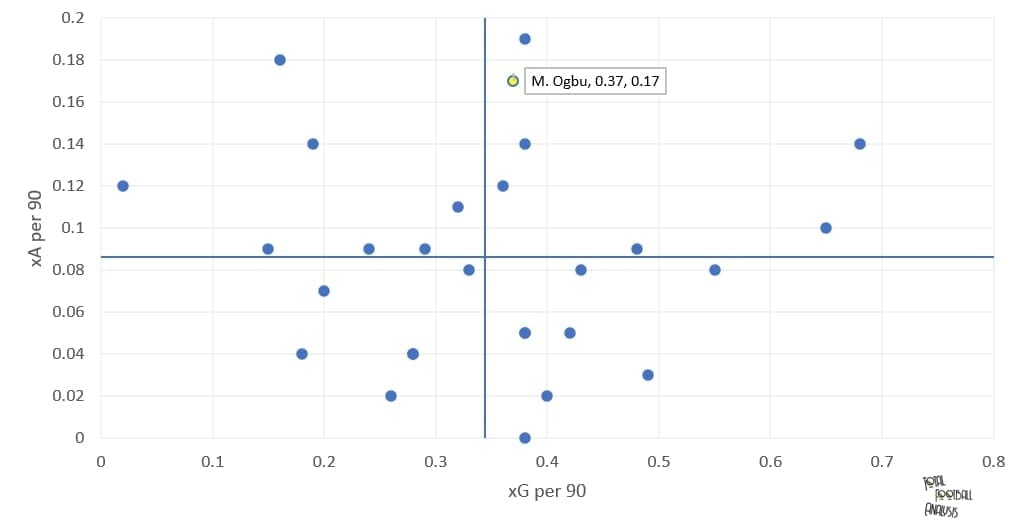
Maybe surprisingly, by comparing the dribble stats, Ogbu shines and stands in the top-right quadrant again. The Nigerian striker has 6.17 dribbles per 90; that implies his willingness and potential to engage in 1 v 1 situations. Only one striker – Nebiyou Perry at Östersunds FK – has more attempts per 90 than Ogbu.
The success rate is quite good as well – 50.72%, which is above the mean. Given the large numbers of dribbles per 90, it is a very difficult stat to achieve. I will delve more into in-game examples afterwards.
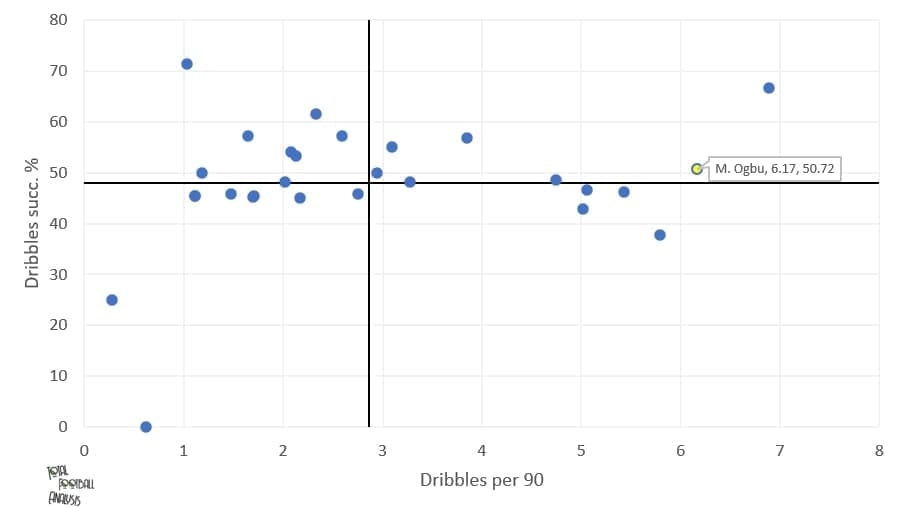
Physical strength and dribbling to develop an attack
Mjällby are a very direct team as they like using long balls to organise an attack or create chances through offensive transitions. Without too much support, the individual ability of Ogbu becomes vital to make something happen as he cannot just stand and wait for his teammates to create the chances.
The strikers at Mjällby should use their body to hold-up play for the long balls if they are not contesting it in the air and trying to flip it behind. Although Mamudo Moro is more often the target man, Ogbu should also use his physical superiority when needed.
There were cases that the pass was too fast and the teammates were yet to arrive at a supportive distance. If it’s not possible to turn and drift into the final third, the physical presence of Ogbu could keep the team’s possession until a better chance arises. For example, Ogbu used his upper body strength, separating the ball and the challenging defender. His closer foot was preventing the potential challenge while quickly turning by using the other foot.
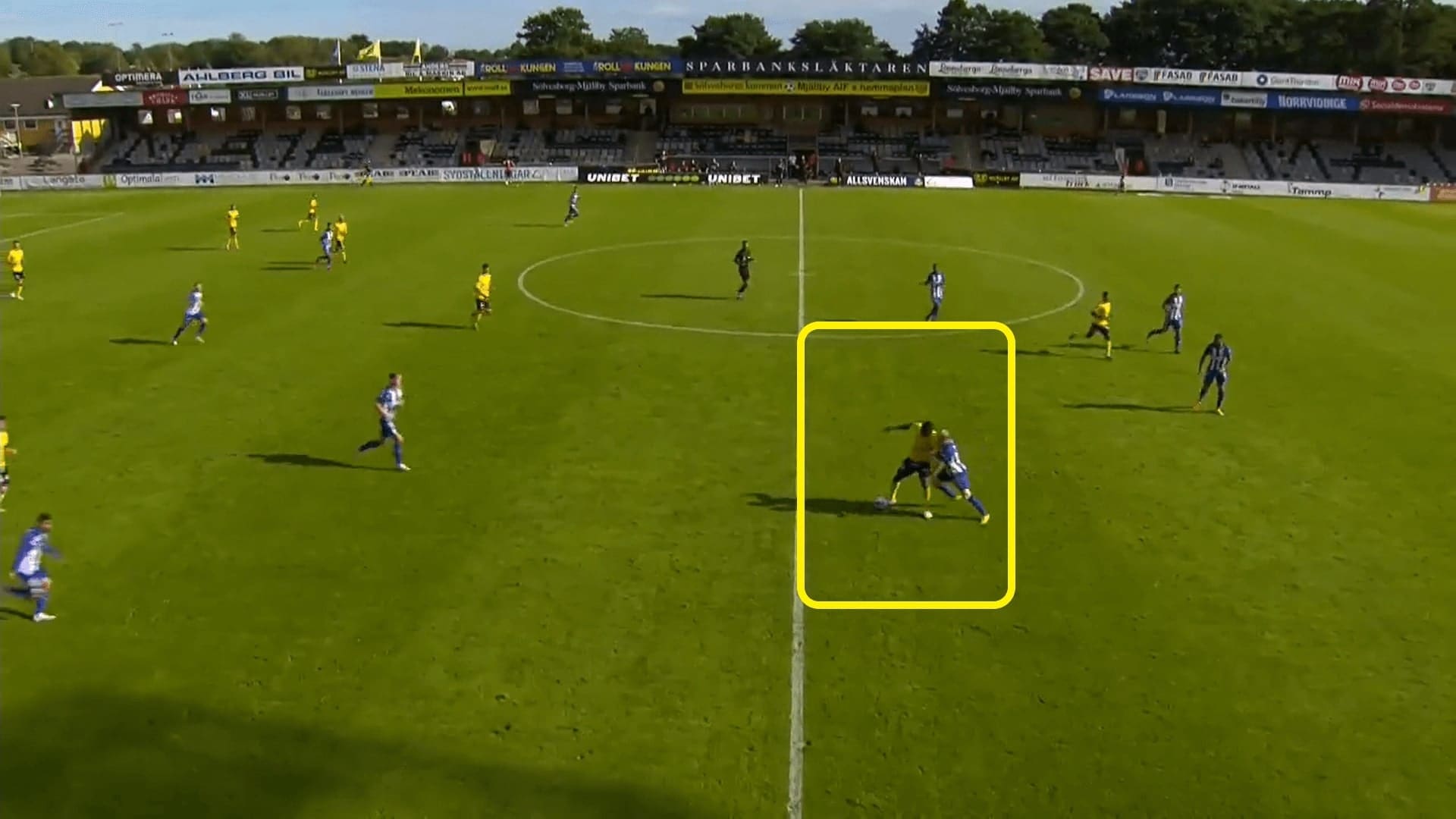
As suggested in the above analysis, Ogbu was used in a two-striker system with another partner, mostly Moro. The duo needed to cooperate through movement to capitalise on the relatively unorganised defence when chasing a long ball.
After picking the first or second balls, this was usually the part when Ogbu could showcase his dribbling. Since supportive players might not be available instantly, Ogbu had to all alone at times, as an alternative to and contrary to the above example.
Here, his partner – Taylor Silverholt – made the outside-forward run to attack spaces behind the backline and pulled the defender away. Ogbu quickly took the ball into the opposite direction, the initial area that was freed up by Silverholt. He likes to turn the ball to the centre or a forward direction that facilitates ball progression, although not every decision is optimal when doing this.
Despite many limitations, his dribbling stats are outstanding. Given his big body, constantly changing direction and pace is impossible for Ogbu, as well as carrying the ball to travel a long distance. After the first sprint, he has to pull the trigger or release a teammate.
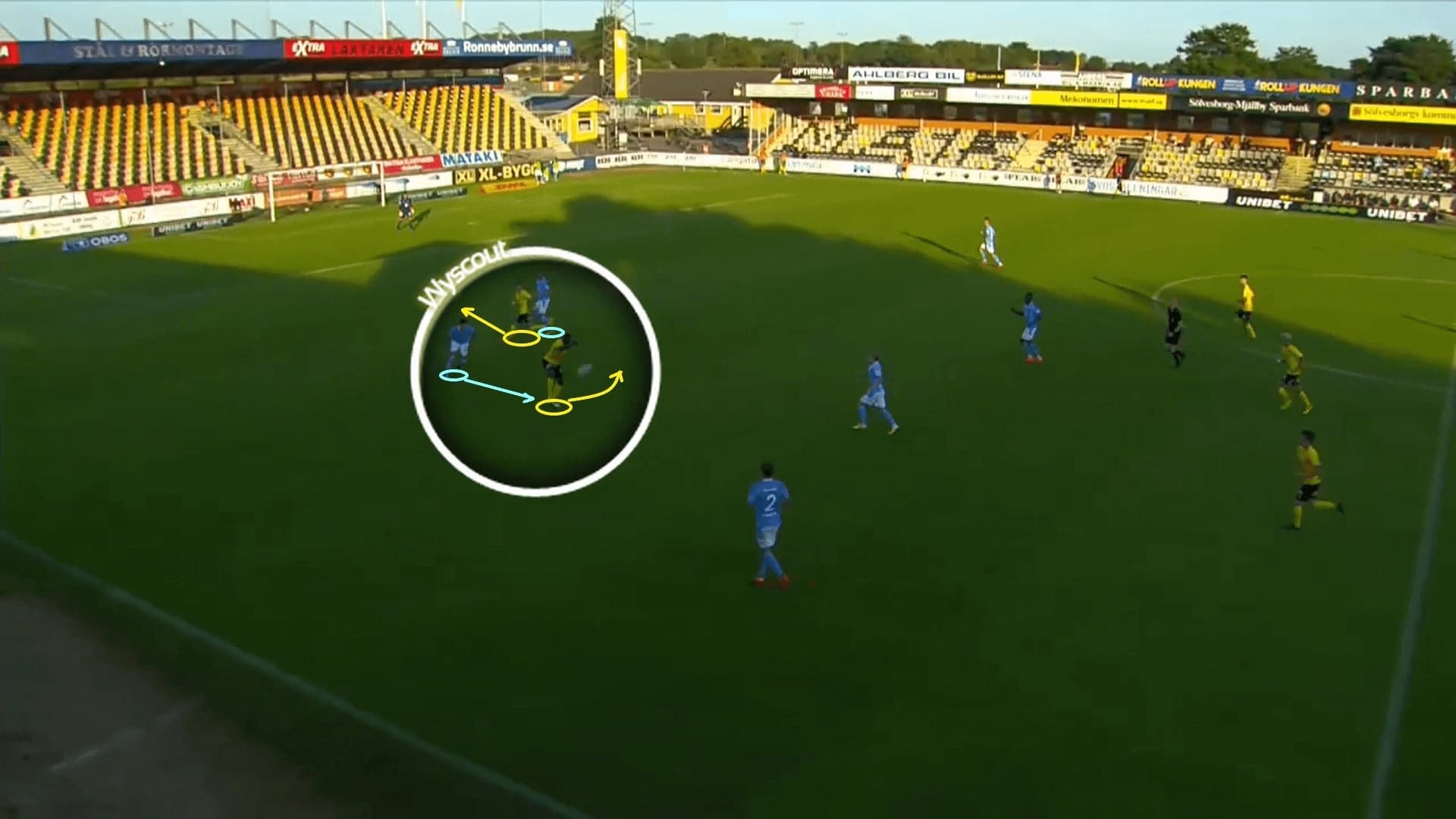
Similar concepts and movements are also used in transitions, triggering the counter-attacks. Given huge spaces in the attacking half, Ogbu and his partner are used to attack the centre-backs by creating separations and isolations, especially against teams that play with a back four.
In this example, Moro ran inside-out, pulling the Djurgårdens IF centre-back – Jacob Une Larsson – out of position. Ogbu’s sensitivity to read and recognise the movements of his partner and opponents has helped him to run into good areas – including running from Jesper Karlström’s blindside to attack spaces created by Moro.
More of this aspect is about creating chances for himself, shooting and moving near the penalty box, which is explained in the coming section.
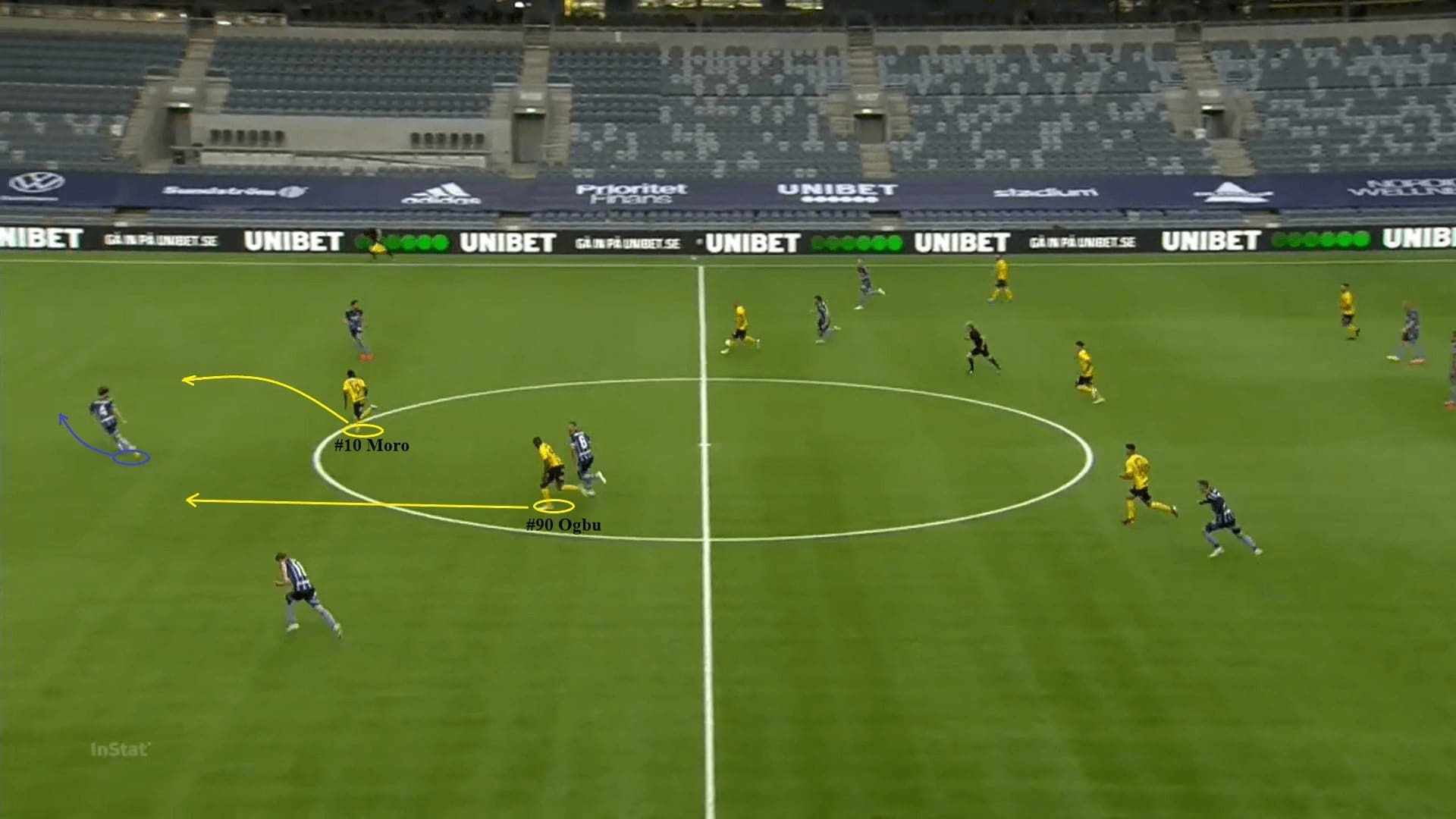
Movement and shooting in the final third
Ogbu has been a clinical goal-scorer this season, scoring eight from 21 shots, with 52.4% of shots being on target. It is a pretty strong record for a striker. He has a strong sense of shooting in good positions. And below we can see the shot map of all of his attempts.
This shot map shows the vast majority of Ogbu’s shots were coming from the “golden zone”, or the shooting zone, which is the central zone of the penalty box. In other words, the 29-year-old player tended not to shoot from either half-space.
Another intriguing pattern about the positionings of shots was the tendency around the penalty spot – Ogbu was not shooting inside the six-yard box. The only goal in that region was attributed to a set-play, so an exception. But we are looking at the movement and the habits of the player.
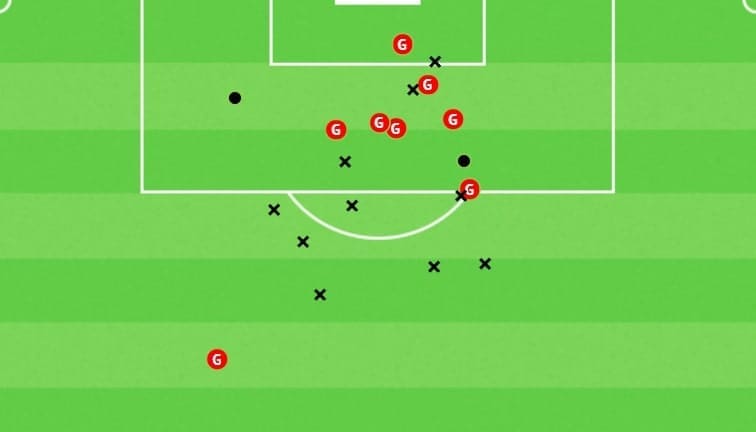
Ogbu’s movement is mainly separated into two categories near the penalty box. The first is a forward-out movement, which means the striker is moving to one direction (forward), assuming the defender also retreats with his blindside turned to Ogbu. Then, Ogbu suddenly moves laterally or diagonally into space the moment the defender was too late to react.
Below is an example, as Franz Brorsson retreated deep to try and contain Ogbu’s run. At the time that Mohanad Jeahze crossed the ball, Ogbu changed his direction in an instant, jumping out from Brorsson’s blindside. This sudden change of direction has created a pocket of spaces to shoot.
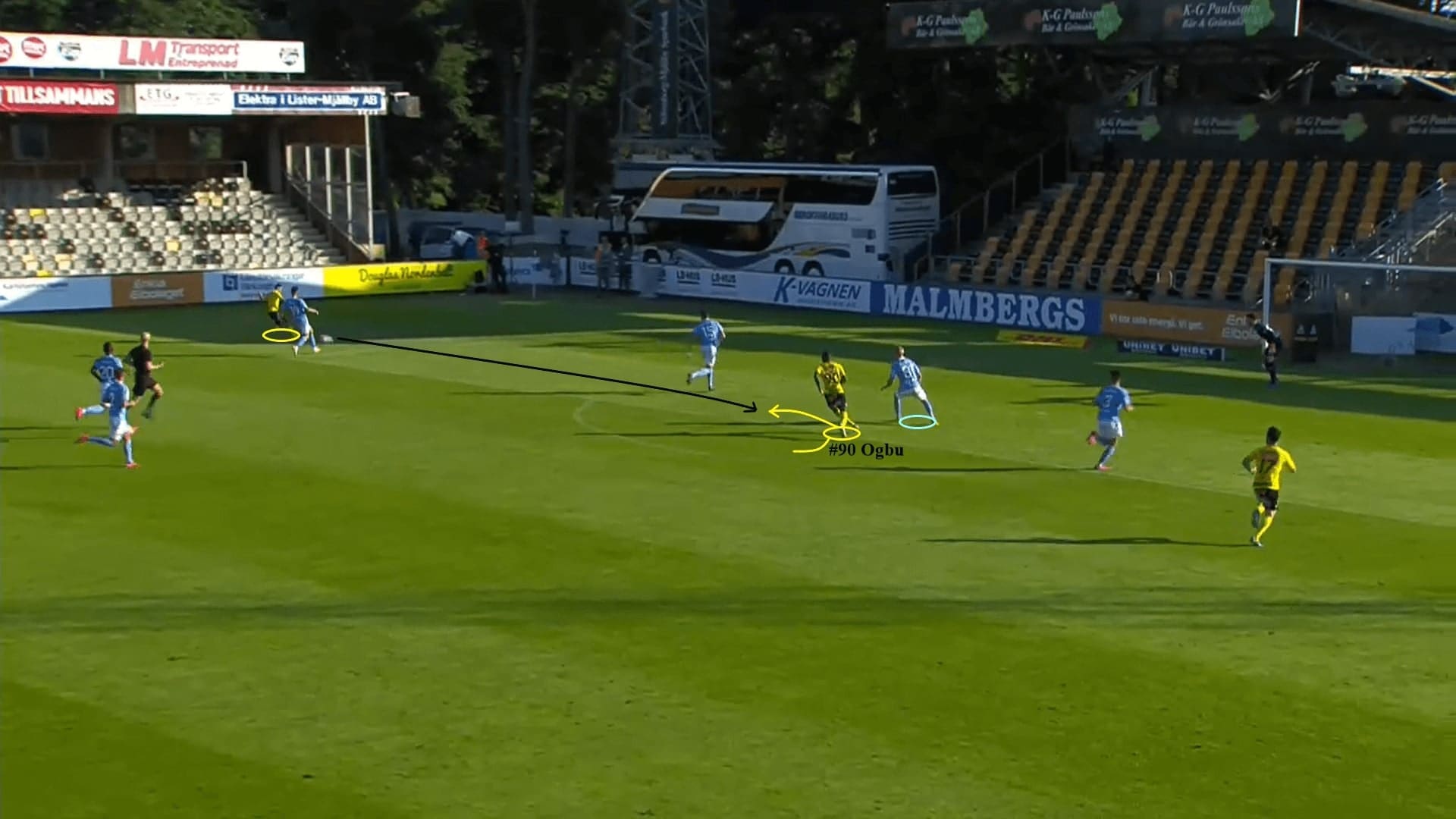
The similarity of these movements is that Ogbu seldom attacks the six-yard box, even when he could be the highest point of the attack. Comparatively, he tended to utilise his partners as decoys to create a pocket of space in front of the defence to shoot.
Some goals of Ogbu did come from this pattern. Usually, he capitalised on another striker’s forward movement that forced the backline into the six-yard box, so that the penalty spot was free. When the cross came in, he could pull the trigger in a lot of space. He delayed his run and only attacks those spaces until the very last moment.
In addition, the delayed timing to move into space also allowed Ogbu to generate power when shooting with his first touch. Sometimes the distances were too close for the keeper to react, and all he needed was to touch the ball at that particular moment.
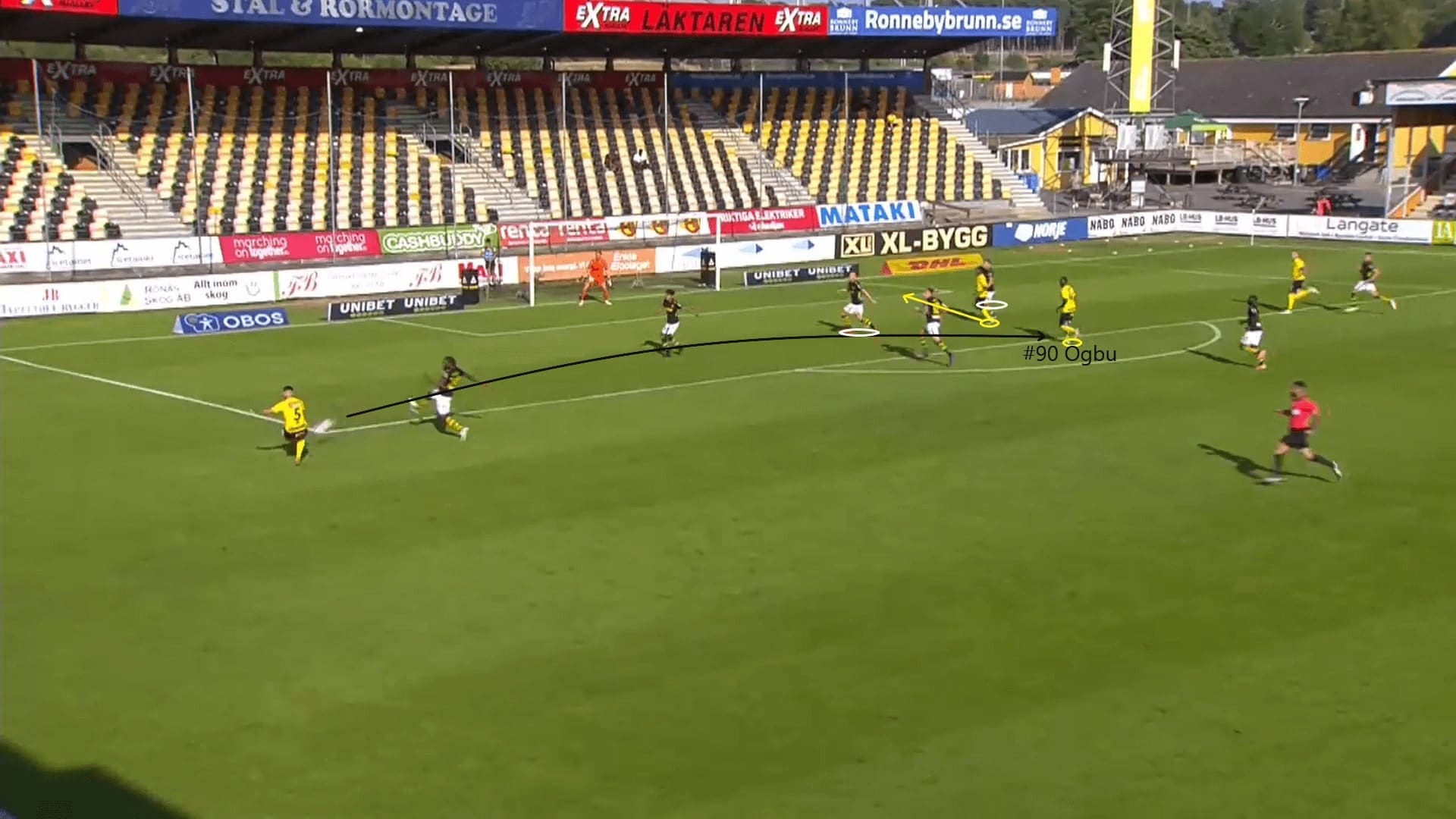
Other skillsets and set-plays
Because the physical quality of Ogbu is strong that he became a dominant force in Allsvenskan, Lantz also gave him a specific role during set-piece plays. It is a commonly seen routine of Mjällby – blocking the goalkeeper or even a defender inside the six-yard box.
Here, as an example, Ogbu occupied two players during a corner. The follow-up behaviour was a bump that pushed the defender away, creating spaces for himself to head the ball into the goal. The physical presence of Ogbu could potentially be used as a counter against the zonal defensive system – deploying the 29-year-old striker as a blocker to stop the defender from heading the ball.
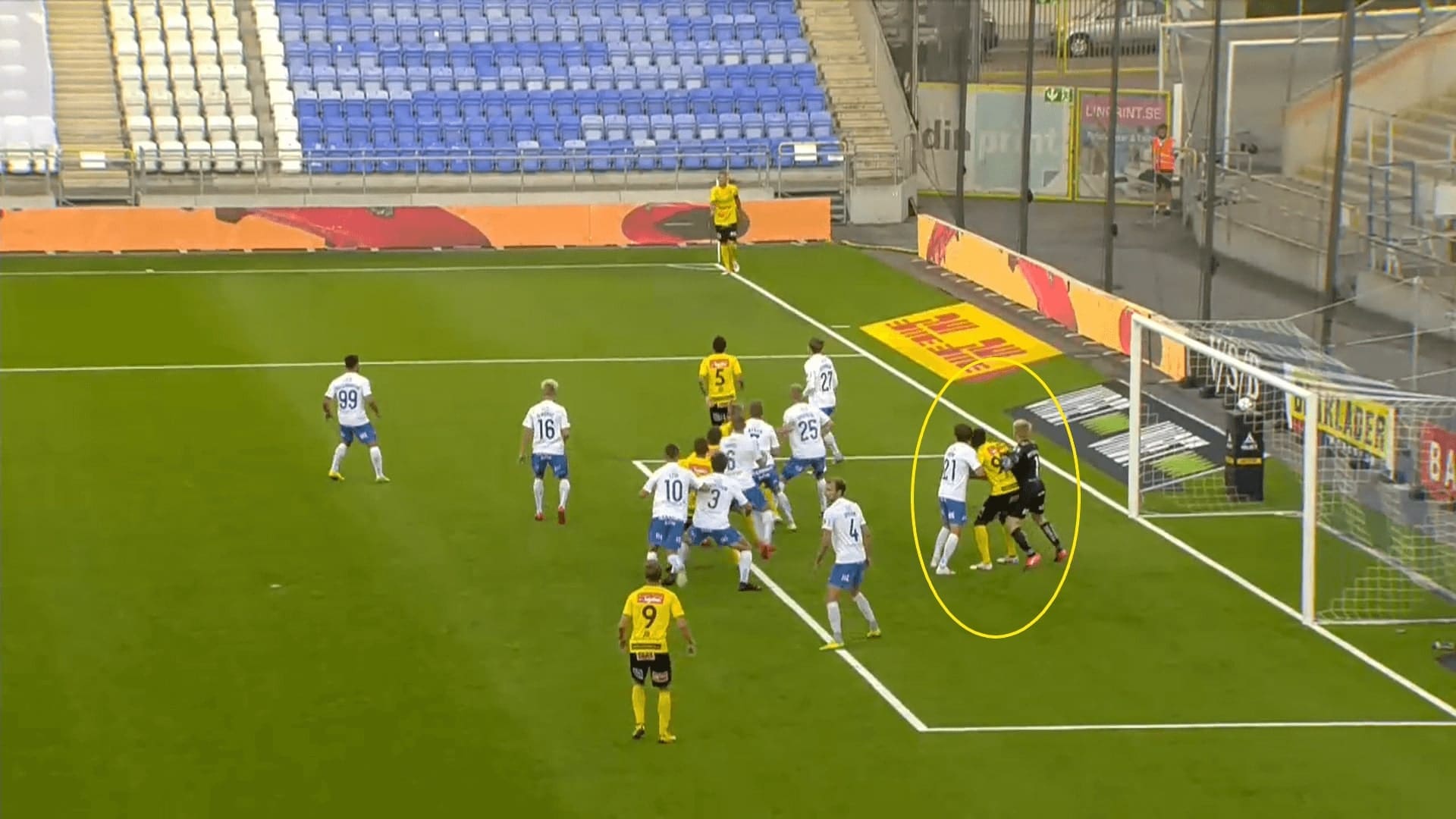
Maybe as an additional skill that he learnt in England, Ogbu can also play long-distance throw-ins. If properly practised as an offensive route to attack the penalty box, this could be another source of goal for the team, likes how Malmö FF utilised Jonas Knudsen’s skillset in offensive throw-ins.
In this example, a match against Djurgårdens, the ball has actually arrived the six-yard box, proving the prowess of the throw-ins from Ogbu.
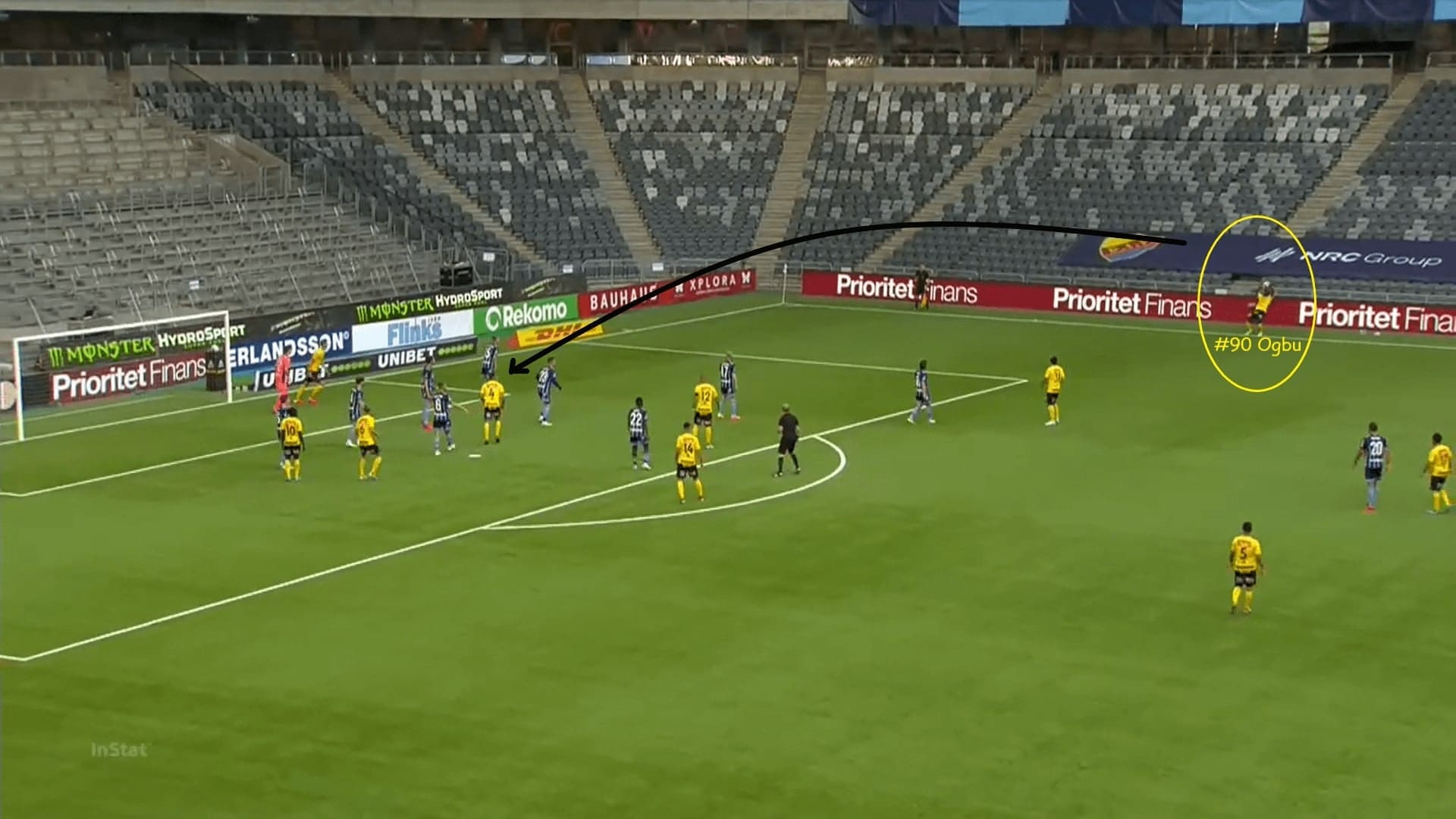
Weaknesses and development
Although Ogbu is a decent striker, just like 99.9% of the players in the world, he also has weaknesses. When controlling in tight spaces, sometimes the first touch is imperfect – the ball is too close to the foot, which hinders the follow-up movement (turn, dribble, or pass).
In terms of shooting, Ogbu likes to go for power and has the muscles to generate power without swinging his foot a lot. I have a small concern with regards to whether Ogbu can perform at the same standard as the lone striker, for example, in the 4-3-3 or 4-5-1 formations. The pie chart below summarises goal types of Ogbu in Allsvenskan 2020 – five right-footed goals, two left-footed goals and one head goal. Despite the number of head goal being negligible, it is understandable – Ogbu does not like to attack depth when the crosses are travelling from the wide zones.
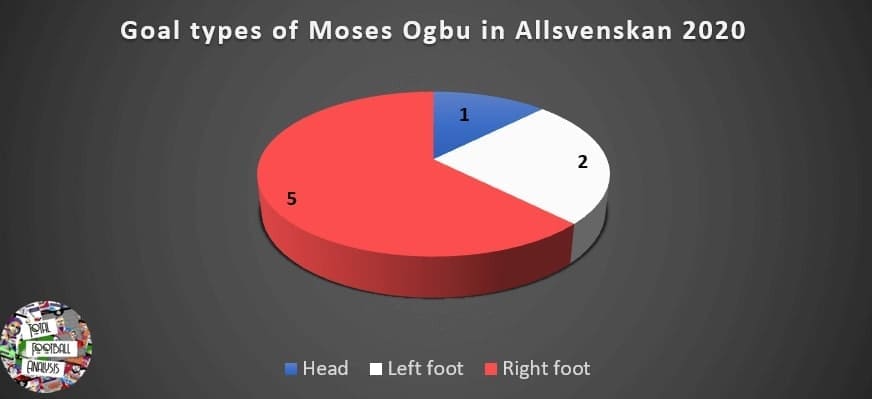
Defensively, the output required by Lantz at Mjällby is not very high, especially since the team seldom press high and collectively in the opposition half. Ogbu does not spend a lot of time to press or attack the ball. For a more well-structured defensive scheme such as requiring the players to shield the passing lanes, pressing as a unit and covering each other, Ogbu will need to improve and adapt to the new systems.
Final remarks
This is probably one of the best seasons in Ogbu’s career. When playing for Sirius, the striker also had some enjoyable moments, scoring 18 goals in a season at Ettan Sorra. This is very different given the standard of Allsvenskan is much higher than the 3rd division. Another promising fitness record was the injuries of this player as Ogbu was often fit to play most games, except an ankle injury that kept him sidelined for 217 days years ago.
The analysis has explained the strengths and weaknesses of Ogbu. Despite the incredible development of the player, playing complicated positional plays, and in tight spaces are still things he needs to improve upon. Overall, Ogbu would be a good fit for teams with a more direct approach in attack.





Comments